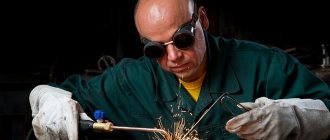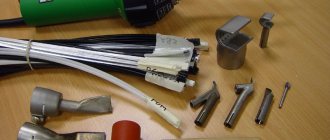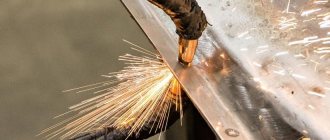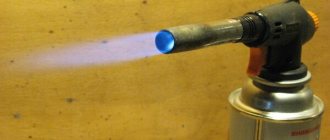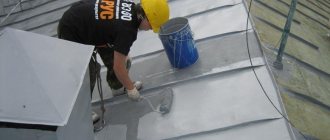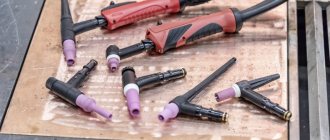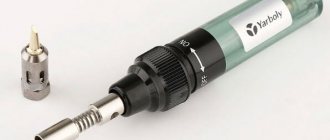For owners of country real estate, and simply for those who like to make things useful for the household, the need to solder something periodically arises. A gas burner is well suited for this purpose, with which you can heat parts for their subsequent processing, soldering or repairing the roof.
Agree, now it’s not a problem to buy a high-temperature burner at a hardware store, but such a device will cost several times more than a homemade one. And the burner will work no worse than its factory counterpart.
From our material you will learn how to assemble a propane gas burner with your own hands, what tools and materials will be required for this.
What is a roof burner
A roofing gas burner is a special device designed for installation of built-up roofing materials. In addition, using such equipment, certain elements are heated, surfaces are dried, paint is fired. A typical gas burner model includes the following elements:
- glass made of heat-resistant iron alloy;
- gas supply wire;
- ignition nozzles protected from the wind.
A gas burner for roofing is a small-sized device with strong handles for transportation. It has a relatively small weight (up to one and a half kg) and is equipped with a comfortable plastic or wood handle .
Propane gas is often used as fuel, but on sale you can find devices that run on diesel fuel. The substance enters the device through a gas pipeline. The gas supply and fire intensity are regulated by a special valve located on the body. The integrated gearbox allows you to minimize fuel consumption and control its consumption.
All models of gas burners for roofing work are equipped with an air suction system. A similar function is indispensable. Additional options that increase convenience include the choice of operating modes. For example , when a propane roofing burner stops, the standby mode automatically starts, which allows you to save gas. Such equipment lights up with a regular lighter or matches.
Types of gas devices
For installation of bitumen roofing, manual burners are used. They are often “powered” by propane. It is very convenient to use such equipment, and the flame length is adjusted using a conventional lever mechanism . Gas-air roofing burners are considered the least dangerous
Valve models are characterized by low weight and ease of operation. In addition, such equipment is not difficult to repair. Producing an intense flame, they work perfectly even in strong winds.
There are also acetylene roofing torches that operate on a mixture of oxygen and acetone. They are often used for welding.
Compliance with security measures
Due to the fact that you will have to work with fire, you must be as careful and prudent as possible. To avoid unnecessary problems, you must follow the following rules:
- roof installation must be carried out in non-slip shoes and special clothing;
- it is necessary to use the insurance system;
- before turning on the device, you need to carefully examine it for flaws and defects;
- during operation, it is necessary to frequently check the tightness of the gas hose;
- It is prohibited to leave the work area while the equipment is running;
- When extinguishing a device, you must first turn off the gas and then press the locking lever.
Equipment manufacturers and their costs
Now on the Russian market you can find various types of roofing burners, both foreign and Russian made. Users speak positively about equipment from the Size and Donmet brands. The products of these companies are characterized by the highest safety and excellent quality. Typically, these are cheap devices that are suitable only for minor roofing repairs. The most productive and advanced equipment is produced by Poap and Rothenberger. These devices are equipped with comfortable operation, a huge number of functions and immense control capabilities.
If you need to make light repairs, it is best to purchase a model that costs up to 1000 rubles. Within the range of 700-900 rubles you can get very good products. Products with the highest price are characterized by greater performance and reliability. Some craftsmen, in order to save money, are going to make a burner with their own hands. As a result, they end up with equipment that is in no way inferior in quality to “purchased” devices.
Self-production of the device
A roofing material burner is a very complex device. To independently produce such a device, it will be useful to study a huge number of rules and have certain abilities. One way or another, it is better to entrust some part of the work to experts. This applies to the fuel storage vessel and its supply system.
A divider and an alloy rod are used as a torch. The handle must be made of heat-resistant wood. The wire supplying the gas can be created with your own hands from brass or borrowed from a welding system.
Interesting read: DIY scrapbooking die-cuts
It is necessary to work with homemade equipment very carefully, checking for malfunctions and fuel leaks. Even with a minor dilemma, it is better to immediately stop treating the roof.
Gas burner for roofing work
The past decade has been characterized by the emergence of revolutionary changes in the technology of arranging soft roofing. Traditional roofing felt has given way to modern built-up materials. The composition of the tools needed to perform roofing work has also changed. The bucket of bitumen and brush were replaced by a roofing torch.
How to lay roofing felt using a gas burner?
Clean the base of the roof from debris. Roll out the rolls of roofing felt with an overlap of 85 cm, glue the ends to the base of the roof on one side, then roll the rolls back. Heat the base of the roof and the inner side of the slowly rolled out roofing material, press the roofing material tightly to the base of the roof with a roller, trying to avoid the formation of air bubbles and folds.
Using a special hook, hook the edges of the roofing material laid overlapping and heat it with a burner, checking the tightness.
The minimum temperature at which a roofing burner can be used is minus 15 degrees Celsius.
What kind of equipment is this anyway?
A gas torch is an indispensable hand tool for performing work on installing soft roof coverings using modern weld-on materials. The flame created by the operating burner allows for local heating of the surface to perform the following operations on the roof:
- drying wet areas of the underlying surface;
- heating and melting of the lower bitumen layer of the welded roll material.
In addition to performing work on the roof, a roofing gas burner is used:
- for heating various products and materials to the required temperatures;
- when soldering metals with light alloy solders;
- for burning old paintwork.
Burner design and mechanism
The roofing gas burner includes the following elements:
- nozzle – supplies gas to the combustion zone through a special calibrated nozzle;
- burner glass - mixes flammable gas with air sucked through the holes, protects the flame in the combustion zone from being blown out by the wind;
- control valve - shuts off the gas supply, allows you to adjust the length of the flame;
- main tube – moves the combustion zone in the glass away from the handle and operator’s hand;
- wood or plastic handle – allows the operator to comfortably hold the burner in his hand.
To operate the burner you will need the following additional equipment:
- liquefied gas cylinder;
- gas reducer - reduces the gas pressure from the cylinder to the working pressure (0.1 - 0.15 MPa), equalizes the gas flow in the burner;
- flexible hose – connects the burner to the output of the reducer.
The weight of the burner is small, no more than 1 - 1.5 kg. Almost all models have the ability to switch to standby mode, when during short breaks in operation the gas supply is reduced to a minimum, allowing the flame not to go out.
A convenient function that saves gas and eliminates the need to re-ignite the burner after interruptions in operation. To ignite the burner, an external flame source is usually used: matches or a lighter.
Gas burner device
Approximate structure of a gas burner
The gas burner has a fairly simple design. It is a glass made of metal and equipped with a nozzle and a handle, which is attached to the body . Heat-resistant plastic or wood can be used to make the handle. Gas enters the housing passing through the gas pipeline. In most cases, propane under pressure is used to operate the burner.
The burner glass should have a shape that protects the flame from being blown out by the wind.
There is a valve on the burner body that allows you to adjust the flame length and intensity of the supplied gas . It’s good if the burner has a reducer, which allows you to use gas economically.
Roof burner models
- GGS-1 is a more common and necessary model. Flame length 600 mm. Versatility and low weight determine a wide range of implementation.
- GG-2 is the basic model of a gas burner. It has a beautiful price-property ratio. An excellent choice for DIY roof repairers.
- GG-2U - the model is similar to GG-2, but differs in the shorter main tube. Comfortable for working in inaccessible places.
- GG-2S – the beginning of the professional series. The burner is adapted for operation in strong winds.
- GGK-1 - has a weighted glass and a trigger gas supply mechanism.
- GGS-4-1.0 - has 4 glasses, immediately engulfs the entire width of the roll with flame. Significantly speeds up work on huge volumes of roofing work.
Gas burner: price and characteristics of some popular models
Gas-air burners for roofing are the safest tools. They are easy to use, lightweight, and capable of creating a flame of sufficiently high power. Modern manufacturers offer models that operate without oxygen:
- GG-2 – propane burner for the roof. This is the best option for craftsmen who perform repair work themselves. It has an acceptable cost;
- GG-2U is a device similar to the previous version, but this model is characterized by a shortened version of the gas supply hose for the gas burner. This device is ideal for performing work in hard-to-reach areas of the roof, as well as for gluing joints;
Before purchasing a burner, it is important to read the specifications of the model and check the quality certificates
- GG-2S is a model that belongs to professional tools and runs on propane. The main advantage of the device is that the device can be used even in strong winds. The device is equipped with two valves and consists of two housings, making it easier to control the operating modes of the device;
- GGS1-1.7 is a universal design, which, despite its small size and weight, is characterized by a high degree of performance. The device can only be used on flat horizontal areas;
- GGK-1 - this burner is heavier than previous designs and is equipped with a very durable glass. This model is suitable for burning old paint, wooden surfaces, as well as for performing waterproofing work. Fuel is supplied using a special lever.
- GGS1-1.0 is used for small works of insignificant volumes. Optimally used on roofs with a large angle of inclination;
- GGS1-0.5 is used for minor repair work. The model is characterized by low fuel consumption;
- GGS4-1.0 consists of four bells, thanks to which the entire roll is heated simultaneously. The use of this option allows you to increase labor productivity and save fuel;
Gas-air burners for roofing are considered the safest tool
- GV-3 is a propane torch designed for welding and even manual soldering of metal. The diameter of the glass is 5 cm;
- GV-111R is used for melting bituminous materials and firing a layer of paint.
- GV-550 and GV-900 are very easy-to-use designs that differ from each other only in the maximum flame length. The first model is more suitable for performing tasks at the junction points of the roof, and the second device allows you to work while standing at full height, since the length of the torch reaches 90 cm;
- GV 500 is used to perform surfacing work during laying of roofing materials. This model melts bitumen with ease. The flame temperature of the GV 500 gas burner is 300 °C;
- GV-850 is a burner that has a special valve, thanks to which you can precisely regulate the amount of technical gas supplied from the cylinder. There is also a lever installed here, with which the master adjusts the length of the torch. This gas burner does not operate on pure propane, but on a mixture that contains technical oxygen. The price of a gas burner for roofing GV-850 is 1700-2200 rubles.
As you can see, the choice of gas burners is very wide, and where to buy a burner: in a store or on the website depends on the wishes of customers. The main thing is to read the specifications of the model and check the quality certificates for the product.
Helpful advice! GV class models are suitable for heating non-ferrous and ferrous metals, melting bituminous materials in rolls when performing waterproofing and roofing work, as well as in cases where the use of only propane is required.
Gas burners are easy to use, lightweight, and capable of creating a flame of sufficiently high power.
Stages of work when laying material with the introduction of a roofing burner
Work on arranging the roof with rolled fused materials is carried out in several steps:
- preparing the surface to be covered , removing the old bitumen coating;
- the roof surface is carefully swept ; it is comfortable to use compressed air to remove debris and dust;
- if there are significant bulges , a concrete screed is made;
- increasing the adhesion of the coating is achieved by applying a thin layer of primer or special polymer mastic to the surface to be covered;
- the roll of material to be deposited is carefully heated by the flame of a gas burner; a change in the color of the pattern on the lower surface of the material indicates that the desired temperature has been achieved;
- the roll is rolled out and the material is pressed tightly against the surface to be covered with a manual roller;
- any subsequent roll is positioned in such a way that an overlap of 8–9 cm wide is formed with the previous strip of material.
Interesting read: DIY glass cutting
How to make a gas burner with your own hands?
Now manufacturers offer a wide range of gas burners that can satisfy virtually any user. But, there are times when a homemade tool takes up decent space in a home workshop.
Making a gas burner with your own hands is completely doable at home. If for one reason or another you cannot purchase or create a burner, you can rent/rent it.
What will you need for this:
- Gas jet with a diameter of the nozzle passage of 0.8 mm. The easiest way is to pick up a carburetor from an old car. Home gas stoves are often equipped with a set of additional jets.
- Gas line - copper or brass tube 70 - 80 cm long . The diameter and thickness of the walls are selected such that it is possible to cut the internal thread from one edge to secure the nozzle.
- Wood or plastic handle. Wide range of options. Must be beautiful and comfortable.
- The glass is the body of the burner and protects the combustion zone. You can pick up a piece of thin-walled iron pipe 100 - 140 mm long, with an internal diameter of 25 - 40 mm. Can be made from sheet alloy 0.8 - 1 mm wide. Connect the edges by welding or using rivets. Materials for production: soft iron, copper, brass.
- Control valve. Perhaps a more difficult question is in the design. It should simply shut off the gas and be comfortable to use. You can look for it among the water supply fittings, or pick it up from a home gas stove that has expired.
- Gas cylinder, reducer, flexible hose. There is no need to invent anything, just take something ready-made. These elements directly address issues of non-hazardous operation.
We assemble in the following sequence:
- In the gas main pipe, cut an internal thread on one side and screw in the nozzle.
- We attach a glass to this side of the tube from the outside. We use three spacers from available material.
- We drill a hole in the handle , insert the other end of the gas line into it and secure it with glue.
- We connect the outlet of the control valve to the end of the line protruding from the back of the handle.
- We connect the input of the control valve to a flexible hose and secure it with a clamp.
- We connect the second end of the flexible hose , the reducer, and the gas cylinder.
- We apply gas, wait until the gas pushes out the air in the hose.
- We light it and adjust the required flame length.
Propane burner device
Before you start making your own gas burner, you should understand its design features and operating principle.
Typically, a propane torch consists of the following elements:
- frame;
- lever;
- distribution nozzle;
- gas hose;
- gas tube;
- propane tank;
- gearbox;
- clamps for fastening.
Propane is supplied through a hose from a pressure cylinder. The volume of gas is regulated by the operating valve on the cylinder, but for safety reasons it is worth additionally installing a reduction gear.
These are the main elements that will be present in a homemade device. But depending on the chosen modification, the design may vary slightly
A shut-off valve is used to open/close the gas supply. It is located behind the main valve. The flame intensity is adjusted using a working tap.
At one end of the gas hose through which gas is supplied, a special nozzle is attached, at the end of which there is a nipple. The nipple together with the gas tube are placed in a metal glass, where the flammable mixture is actually created.
Next, the combustible mixture enters the combustion area through a nozzle under pressure. To maintain a uniform combustion process, holes are specially provided in the nozzle.
Having familiarized yourself with the design features of the device, you can begin to create a gas burner with your own hands, especially since it is not as difficult as it might seem at first glance.
Safety rules when working with gas burners for roofing
Carrying out work on the roof with the use of a gas burner immediately affects several sections of labor protection:
- work at height;
- work carried out with open fire;
- appeal with flammable substances.
Taking advantage of it, strictly observing safety precautions, is the basis for preserving human life and health. Accordingly, the entire set of measures to ensure safety can be divided into three parts. Measures to prevent a worker from falling from a height:
- the presence of shoes that prevent the worker from slipping off the roof surface;
- safety devices to prevent falls from a height;
- the presence of fencing of the working area, walking walkways, etc.
Measures to protect workers from high temperatures:
- availability of special clothing, mittens;
- It is not allowed to direct the flame towards people or parts of the gas installation;
- It is not allowed to go beyond the boundaries of the work area or climb the scaffolding with a lit burner in your hands.
Fire safety measures:
- ensure the availability of primary fire extinguishing equipment in the work area;
- work with an open flame can be carried out during daylight hours in the period from 8 to 18 hours;
- there may be no more than one liquefied gas cylinder in the work area at once;
- it is necessary to exclude heating of the gas cylinder;
- Avoid overheating and ignition of the deposited material.
Before starting work, you need to inspect the gas equipment and make sure it is working. Check the tightness of the connections of the cylinder, reducer, hose and burner.
How to use a gas burner: safety rules
The operation of gas burners requires strict adherence to safety rules:
- Work with burners is carried out in special clothing and shoes with non-slip soles. You will also need a belt and walking bridges.
- Before using the tool, it is necessary to conduct an external inspection and ensure that the burner, cylinders and connecting hoses are in full working order.
- During use of the device, only one gas cylinder may be present at the work site.
- Do not stand in front of the nozzle while igniting the gas in the burner. The direction of the metal cup must be such that the fire cannot touch anyone nearby, the gas cylinder and the connecting hoses.
- If you use weldable materials, you must ensure that they do not overheat and do not catch fire. It is necessary to ensure that only the lower part is heated; the material should not be allowed to soften completely.
- The burner can only be lit with matches or a lighter.
- While working with the device, the master is prohibited from going beyond the boundaries of the workspace, as well as going down or up the scaffolding.
Extinguishing the tool occurs in two stages: first, the gas supply is shut off, and then the locking lever is released. Even after a short break in operation, the device should be extinguished. If there is a significant break, then the gas supply must be shut off at the cylinder itself.
Before using the gas-air burner, it is necessary to conduct an external inspection and ensure that it is in full working order.
Helpful advice! If the mouthpieces or connecting hoses are clogged, the device cannot be used, as kickback and popping noises may occur. If backlash occurs or the equipment overheats, you should immediately stop working and turn off the fuel supply to the cylinder. You can cool the instrument by immersing it in a container of water.
Structural features of roof burners
The burner, designed to work on a roof structure, is a mobile device equipped with special handles for moving it. The weight of the unit is about 1.5 kg. The burner has a wooden or plastic handle for operation; its length can reach 1 meter. Such equipment is specially designed for heating welded roofing.
The main operations that can be done using a roofing torch:
- firing of old paintwork;
- cutting, soldering of iron products;
- drying surfaces;
- other work that requires heating surfaces to high temperatures during their implementation.
Equipment design elements:
- glass made of heat-resistant alloy;
- ignition nozzles are equipped with special protection from powerful winds;
- gas supply hose.
Most often, propane gas is used for such equipment, which is supplied to the housing through a special hose. The gas supply and flame length are adjusted using a valve equipped on the tool, and a reducer is additionally used to adjust the flow rate of the gas mixture.
All designs of this equipment have an air suction system. This feature is essential for the tool. To increase the comfort of working with equipment, a special regulator of operating modes is additionally provided, which provides the opportunity to save fuel when the standby mode is turned on. To ignite the flame of the instrument, you need to have a lighter and matches on hand.
Step-by-step burner manufacturing process
The process of manufacturing a gas burner begins with the fact that we insert the supply tube, for which we will use a steel pipe, into the handle and secure it with glue. The divider and body must be machined from a brass rod, the diameter of which should be 20 mm. In the finished body, two radial holes are drilled (each diameter is 5 mm) and four holes are drilled in the divider rod (each diameter is 1 mm).
When assembling, it is necessary to press the divider into the body with a slight tension. At the same time, the flange must be installed inside the housing with a gap, that is, the internal diameter of the manufactured housing must be 0.6 mm larger. diameter machined The resulting gap is responsible for braking the gas flow, which is supplied to the drilled holes in the igniter.
Such nozzles are found in purchased models
Next we grind out the nozzle. For this we need a steel rod.
To make a thin hole in our nozzle, you need to take a drill with a diameter of 2 mm. and use it to make a blind hole, which is 1.5 mm. doesn't reach the exit. Drill with a diameter of 0.4 mm. used for jumper. The resulting hole must be completely caulked with gentle hammer blows. Then you need to sharpen the end. To do this, take sanding paper and sharpen it until the desired cross-section of the outlet hole is found, that is, until the nozzle can be placed on the tip of the threaded burner tube.
A supply hose made of fabric-rubber material must be attached to the end of the gas supply tube. Secure the hose to the tube with a clamp. We set the working pressure, after which we supply gas. Wait until all the air is forced out of the hose, and only then insert the nozzle into the flame of the gas burner.
Attention! The nozzle is introduced into the flame without a housing or a divider.
Next you need to sand the end. The length of the burner flame should ultimately be 5 cm. We put the body together with the divider onto the external thread of the nozzle. Make sure that the burner produces an even flame with no signs of soot.
To achieve the desired effect, slowly rotate the body on the nozzle thread.
If you have a loose threaded connection, seal it with FUM tape.
How to properly use a gas burner for a roof
The procedure for working with a roofing burner using propane gas is divided into separate stages. The main roofing covering, for the installation of which similar equipment is used, is roofing felt.
Work order
- Before starting work, the base for roofing felt is prepared: cleaning of construction debris and other contaminants, smoothing the surface (if necessary, a concrete screed is applied).
- Roofing felt is rolled out on the prepared base, while individual sheets of material are laid overlapping each other.
- Then roll the roofing felt rolls back and fix them at the base of the roof slope with a gas roofing burner. After this, immediately warming up the roofing material and the base of the roof, they slowly roll out the roll covering and painstakingly press it onto the base. Adjacent rolls are soldered together.
- The laid layer of material must be rolled with a roller from time to time so that no air bubbles remain under the coating. The seams are also rolled after soldering.
Operating rules
- It is prohibited to carry out installation work using a gas burner if Toc is less than minus 15°.
- Using this equipment, you can cover a roof with an area of about 500 m2.
- The device must be equipped with reliable protection from powerful winds and have a measured combustion flame.
Preservation techniques
- Before roofing work, gas hoses and gas cylinders are inspected for suitability for use.
- Work is carried out only in overalls, soft shoes and with safety equipment (minimum cables, safety belts).
- The gas cylinder is installed near the workplace; all equipment connections must be sealed.
- The flame at the moment of ignition of the burner, during operation, is prohibited from being directed towards people, a gas cylinder, or hoses.
- It is not allowed to overheat the soft roof covering to prevent it from igniting.
- It is prohibited to leave the workspace with the device running.
- When igniting a propane burner, you must first turn the valve half a turn and vent the device. After this procedure, you can ignite and adjust the power and flame length.
- You need to extinguish the gas burner in several steps: 1st - turn off the gas supply, 2nd - lower the locking lever.
Propane burners: professional and budget models
Experienced foremen usually buy expensive professional models, which are reliable and safe to use. But for a self-taught craftsman, simple and small designs are quite suitable for home use. Let us consider further how the choice of this or that equipment will affect the quality of work.
A simple burner is not intended for industrial work, where it must be used almost every day. In this case, you will need a reliable model that can withstand uninterrupted operation and guarantee absolute safety. At the same time, a cheap and simple design in the hands of a skilled and careful craftsman can last for several decades. Especially if you have to use it only once a season.
Regardless of which product is chosen: an expensive and professional burner with a cylinder or a cheap household design, before each use it is necessary to check the tightness of the product, especially the connection points, the fuel supply hose and the mouthpiece for clogging. If you miss even a minor defect, you can provoke serious problems.
Propane burner is very convenient, reliable and mobile design
Helpful advice! Even for home use, you should not buy the cheapest burner. Most likely, this model will have a weak gearbox, which means that the tool’s performance will be on par with the power of a blowtorch. Working with such a device will be very slow.


